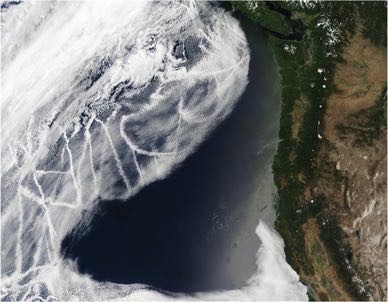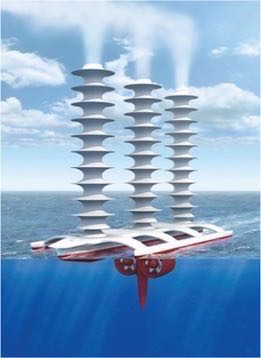3.5 Ocean spray
All the methods you have studied so far involve adding something to the Earth system or Solar System: building a solar shield, coating urban surfaces in new materials, extracting sulfate aerosols from fossil fuels to put in the stratosphere. But another alternative would be to redistribute one part of the system to another where it can reduce the solar energy reaching the surface.
As ships criss-cross the planet, aerosol particles in their exhaust emissions cause clouds to form that brighten the dark oceans (Figure 8). The particles act as cloud condensation nuclei (CCN, as you saw in Session 3). Not only does this encourage new clouds to form, but it also tends to make clouds brighter.
Increasing the number of CCN increases the concentration of cloud droplets, at the same time decreasing their size, which makes the clouds whiter and more reflective. This is because the surface area of the smaller drops is larger, which means they scatter more light.
Low clouds over dark ocean surfaces play an important role in Earth’s energy budget.
CCN could be created from salt by spraying fine sea water droplets from the ocean into the sky (with air turbulence carrying some of them higher), an idea known as marine cloud brightening. This could be carried out by purpose-built, remotely controlled, wind-powered vessels (Figure 9) or by turbines at the back of existing ships.
Marine cloud brightening could in principle offset any amount of CO2 forcing (Lenton and Vaughan, 2009).
-
Brightening marine clouds could be most effective in areas with the cleanest atmosphere – those with fewest cloud condensation nuclei. Which ocean might be most suitable?
-
The Southern Ocean surrounding Antarctica, because there are fewest natural and human sources of CCN.


